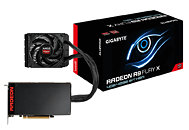Thursday, June 25th 2015

GIGABYTE Announces its Radeon R9 Fury X Graphics Card
GIGABYTE announced availability of its AMD Radeon R9 Fury X graphics card. Based entirely on AMD's reference design, the card features reference clocks of 1050 MHz core, and 500 MHz (512 GB/s) HBM clocks. Since the card lacks DVI connectors, GIGABYTE is including a DP-DVI adapter in its package. Based on the 28 nm "Fiji" silicon, the R9 Fury X offers 4,096 stream processors, 256 TMUs, 64 ROPs, and a 4096-bit wide HBM interface, holding 4 GB of memory. The compact card is cooled by a factory-fitted closed-loop liquid cooling solution. The card is generally available at US $649.99.

5 Comments on GIGABYTE Announces its Radeon R9 Fury X Graphics Card
tho ... i wouldn't assume you simply multiply the mhz by the number of stack otherwise in the case of my 290 you do 16X1350mhz :laugh:
and judging by the performances (at 1440 and more) 4gb of HBM @500 does just as fine as 6gb of GDDR5 @1750
edit: it seems the effective clock is 1ghz versus 7ghz (Fury X to 980Ti)
If you mean how the heck it gets so much bandwidth... wide as f*ck memory bus: 4096 bit (512 Byte), meaning 512 GB/s